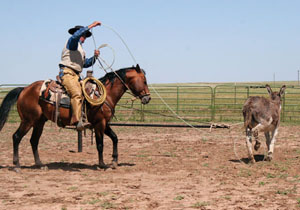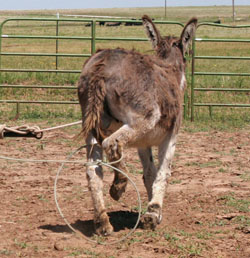Going in Circles Pays Big Dividends When You’re Learning to Rope

I hope you’ve been putting in some time practising on the roping dummy. If so, it’s probably time to take it to the next level. I’ll share what has worked for me to help my roping skills and train my horses at the same time.
You know (without me telling you) that to continue safely, your horse should be bomb-proof and you should be able to handle a rope confidently on the ground. If you’re not there yet, don’t be afraid to seek out some help from an experienced friend or a professional. Keep working at it from the ground and be careful. No exercise is worth the price of your fingers or life.
If you think you are ready to step up, here’s what I do: I use a burro to teach our horses to track and rate stock while I practise my heel shots. Edith, the world-renowned burro — who has become quite famous in the clinics I’ve taken her to — is tied to what I call a “Round and Round.”  She’s able to walk in a slow circle, giving me a controlled yet moving target. Please note that this doesn’t mistreat Edith in any way. I don’t pull tight on her legs, so she isn’t harmed and this actually gives her a productive job — which makes her a contributing member of society.
She’s able to walk in a slow circle, giving me a controlled yet moving target. Please note that this doesn’t mistreat Edith in any way. I don’t pull tight on her legs, so she isn’t harmed and this actually gives her a productive job — which makes her a contributing member of society.
To begin tracking the burro, ask your horse to place his nose (if you rope right-handed) just behind and to the left of the burro’s left hip. It’s important to place your horse so you can clearly see both hind legs of the burro. You can only rope what you see.
When the burro moves off from the pressure of the horse, ask your horse to track and rate. Tracking is simply following the burro’s path and rating is adjusting the horse’s speed to stay the same distance away from the burro.
Building a “Round and Round”
This is a valuable training tool you can build yourself with just a little bit of work and welding.
I start by tamping an eight-foot section of heavy walled pipe, 3¾-inch diameter, into the ground about four feet. This will be your stationary base.

From a four-inch-diameter pipe, I cut a ring collar two inches wide and weld it onto the stationary pipe, about three feet from the top. This leaves about one foot of clearance between the ring collar and the ground.
Next, I place a three-foot piece of four-inch-diameter pipe over the stationary pipe. This overlaying pipe
rests on the welded ring collar and can pivot. Onto the overlaying pipe, I weld a horizontal arm made from a 20-foot section of 1½ -inch diameter pipe.
I weld a support rod, made of half-inch round stock, from the end of the horizontal arm, back to the four-inch overlaying pipe. Where the horizontal arm and the support rod meet, I’ll weld on a ring large enough for a lead rope to pass through.
I also have a fabricated version of my “round and round” that I use on the road. It has a set of wheels to prevent it from tipping over when Edith, the World Famous Roping Burro, goes round and round.

